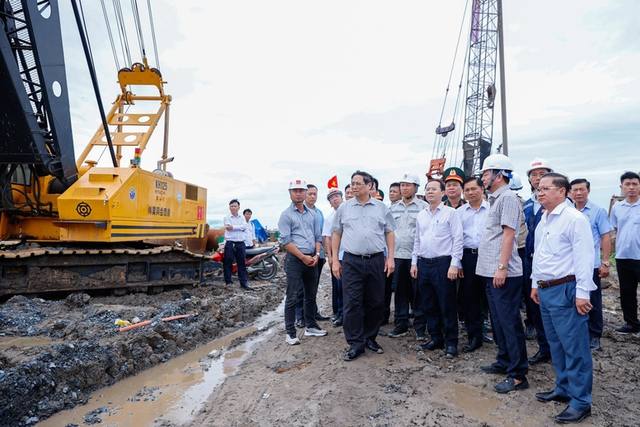Mekong Delta should have around 1,200km of expressways by 2030
VGP - Prime Minister Pham Minh Chinh reiterated the Government's resove to increase the total length of expressways in the Mekong Delta to about 1,200 kilometers by the end of this decade.

Prime Minister Pham Minh Chinh examines the construction of an expressway from Can Tho City to Hau Giang Province, July 13, 2024 - Photo: VGP
Pham examined the construction of an expressway from Can Tho City to Hau Giang province on July 13.
He was accompanied by Minister of Transport Nguyen Van Thang, Minister of Natural Resources and Environment Dang Quoc Khanh, Secretary of Hau Giang Provincial Party Committee Nghiem Xuan Thanh and Secretary of Can Tho Municipal Party Committee Nguyen Van Hieu.
As planned, the Mekong Delta region will have six expressways, with the length of 1,188 kilometers, including three southbound axes (597 kilometers) connecting the region with the southeastern region and three eastbound axes (591 kilometers) linking seaports and international border gates.
The Prime Minister asserted that the transportation system along with other synchronous measures will create a strong driving force for the development of the region, accelerate urbanization and industrialization of agriculture, create jobs, and improve local people's material and spiritual lives.
The Mekong Delta region comprises Can Tho City and 12 provinces namely Long An, Tien Giang, Ben Tre, Dong Thap, Vinh Long, Tra Vinh, Hau Giang, An Giang, Soc Trang, Kien Giang, Bac Lieu, and Ca Mau.
The Mekong Delta has many comparative strengths, with its large natural land area of nearly 4 million square kilometers (13 per cent of the country's total) and huge population (18 million, making up 19 per cent of the country's total).
The region also contributes 12 per cent of the national GDP; 700 kilometers of coastal line and 360,000 square kilometers of the sea surface and an exclusive economic zone connecting major sea lines.
The region with 2.5 million of fertile land enriched by the Mekong River makes it the biggest agricultural production center in Viet Nam–contributing 50 per cent of rice output, 65 per cent of aquaculture production and 70 per cent of fruits–fulfilling the mission of ensuring food security for the country.
The region also has strengths in renewable energy, year-round tourism, and other services.
Viet Nam expects to have 3,000km of expressways by the end of 2025, connecting the northern border province of Cao Bang with the southernmost province of Ca Mau./.
